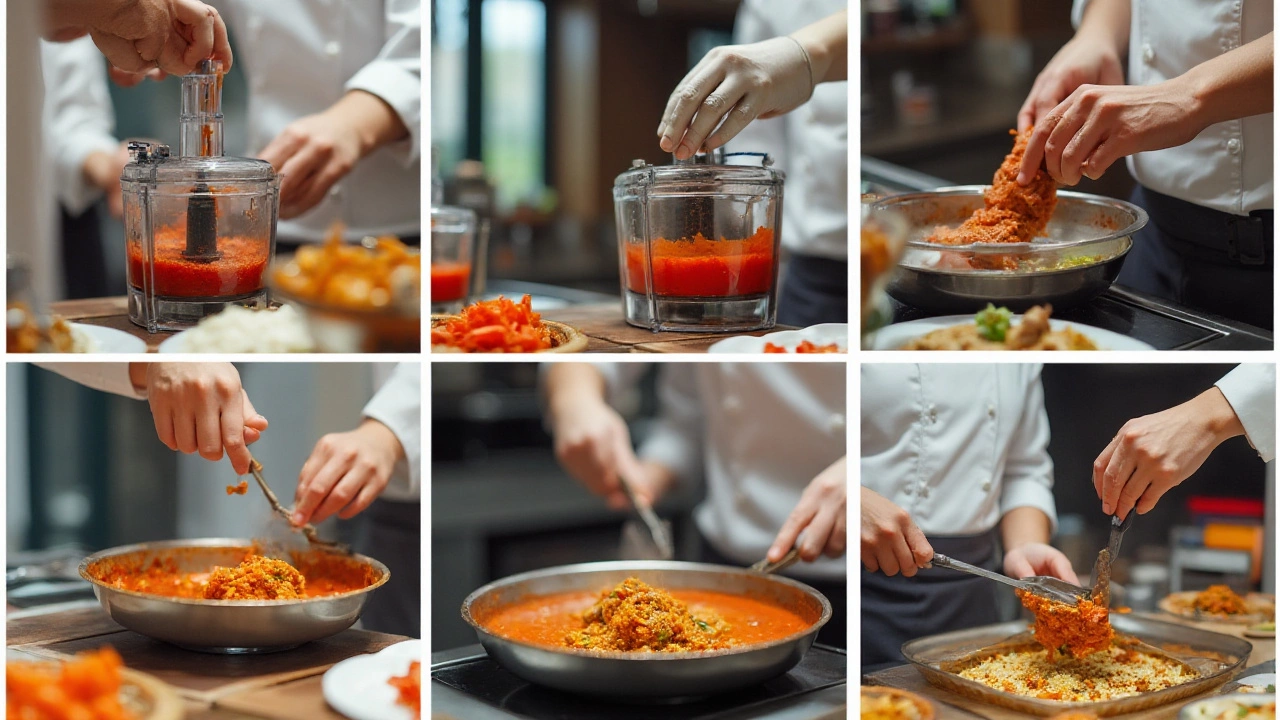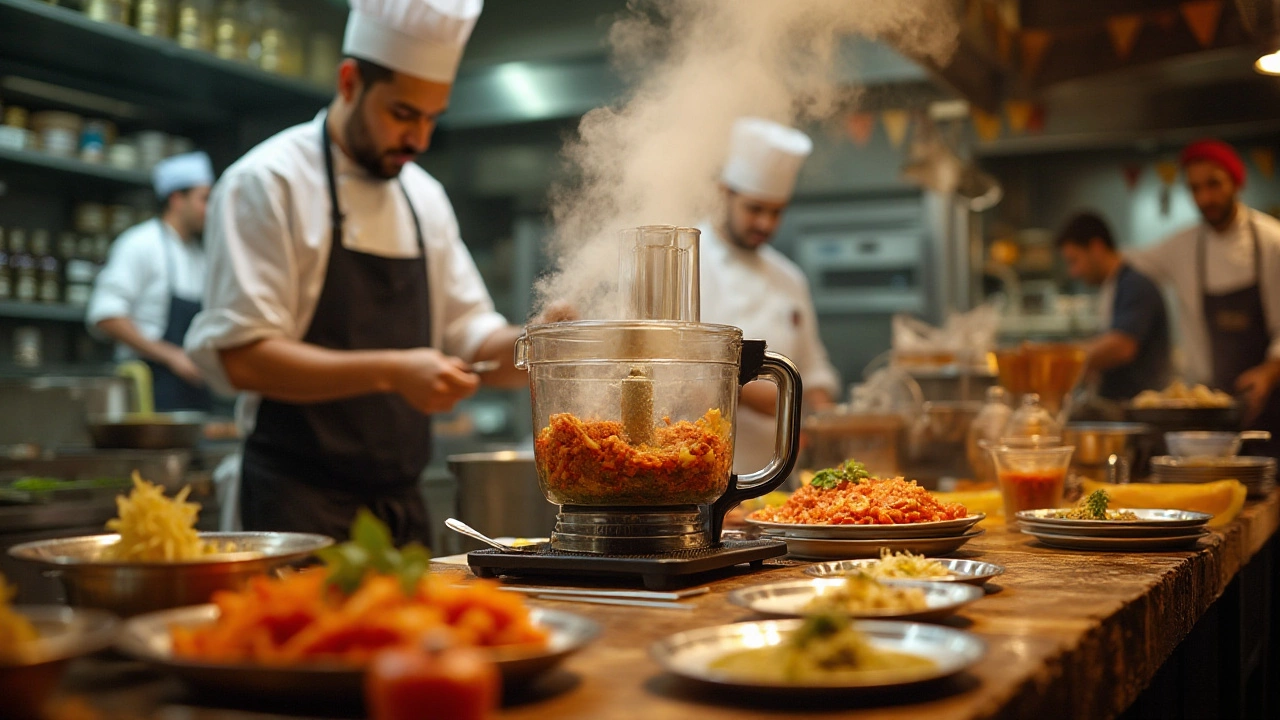In the fast-paced world of restaurants, food processors have carved out a niche as essential kitchen companions. Chefs and kitchen staff depend on these machines for their ability to simplify and expedite various cooking processes. From chopping vegetables to blending sauces, the versatility of food processors means that meals not only reach the table faster but also maintain a consistent quality that patrons expect.
With culinary creativity at an all-time high, restaurants are constantly looking for tools that offer a helping hand without compromising on results. Enter the food processor, which takes on the heavy lifting, allowing chefs to focus more on flavor and presentation. Whether you're curious about how restaurant kitchens operate or contemplating incorporating a food processor in your establishment, this article will guide you through everything you need to know about these essential machines.
- The Role of Food Processors in Restaurants
- Common Uses of Food Processors
- Benefits of Using Food Processors
- Choosing the Right Food Processor for Your Kitchen
- Tips for Maintaining Food Processors
The Role of Food Processors in Restaurants
In the bustling world of restaurant kitchens, the food processor stands as a reliable ally, transforming cumbersome tasks into manageable, speedy processes. Whether a renowned chef or a diligent prep cook, professionals in the culinary world often find themselves dealing with large quantities of ingredients that need precise and consistent preparation. A food processor's ability to slice, dice, chop, and puree foods efficiently makes it indispensable. From mincing herbs to creating smooth pastes, these machines ensure that chefs can maintain a high level of quality in their dishes without the daunting task of manual preparation. Many in the industry have remarked that the savings in time have allowed them more opportunity to innovate, bringing creativity to the fore rather than being bogged down by an endless cycle of prep work.
The restaurant kitchen is an intricate ecosystem where every second counts. Food processors play an integral role in ensuring this ecosystem runs smoothly. Imagine the task of chopping vegetables for a large banquet — this is no small feat. Here, the food processor shines by cutting down the number of man-hours needed for labor-intensive prep work, thus freeing up human resources for other tasks. With the ability to handle diverse ingredients ranging from nuts to dough, these machines adapt to various cuisines, catering to a multitude of culinary needs from around the globe.
Indeed, the benefits of having a food processor extend beyond mere convenience. By reducing preparation times, restaurants can seat and serve more guests in the same timeframe, leading to increased customer satisfaction and, ultimately, higher returns. A testimonial from a chef in a bustling London eatery noted, "
My food processor is like a second pair of hands. It allows us to keep pace during the lunch rush without sacrificing quality." Such efficiency is a crucial factor that significantly contributes to the restaurant's success. In addition, their reliability has altered the way menus are designed, as chefs can confidently offer dishes that require significant prep due to the efficiency of their trusty food processor.
Not only does this culinary tool deliver on speed and efficiency, but it also maintains consistency — an essential ingredient in any successful restaurant's recipe. Consistent dicing or pureeing means that each dish retains the same flavor profile and presentation, without the variations that may occur with manual preparation methods. This consistency is key to customer satisfaction and retaining loyal patrons who expect the same quality with every visit. Moreover, with food safety being paramount, the sealed environment of a food processor minimizes the risk of contamination, ensuring the integrity of the food prepared and served to customers.
Common Uses of Food Processors
Food processors have revolutionized the way kitchens operate, especially in bustling restaurant environments. These culinary powerhouses are incredibly versatile, designed to handle a range of tasks that would otherwise require multiple tools or excessive manual labor. The most frequent application of a food processor is chopping vegetables. In the realm of restaurant kitchens, where time is of the essence and precision is paramount, the ability to swiftly and uniformly chop vegetables can significantly impact the efficiency of meal preparation. These processors are equipped with sharp blades that quickly turn chunky vegetables into finely diced ingredients, perfect for soups, stews, or salads.
Blending ingredients is another common use, particularly in the preparation of soups and sauces. Food processors can easily blend large volumes, combining flavors effectively and ensuring a smooth texture that is often desired in restaurant-quality dishes. This functionality not only saves time but also helps in maintaining consistent taste and texture, which are crucial elements in professional cooking. In the words of acclaimed chef Thomas Keller,
"A great dish is reliant on the harmony of its components, and a food processor helps achieve that balance effortlessly."
Culinary tools like food processors are also employed in the making of doughs and batters. Many restaurants rely on these machines to mix ingredients for pastries, bread, and various desserts. The processor’s ability to incorporate ingredients quickly and evenly is unmatched, leading to better texture and rise in baked goods. In fact, depending on the model and attachments, food processors can knead dough to the perfect consistency, which is essential for artisanal loaves and delicate pastries.
Another noteworthy use is grating and shredding. Cheese, vegetables like carrots and zucchini, and even nuts can be shredded in seconds, allowing chefs to prepare ingredients that contribute texture and flavor to a multitude of dishes. Restaurants that feature salads, pizzas, or gourmet desserts often employ food processors to handle the grating tasks, which can otherwise be quite laborious if done manually.
Finally, these machines are indispensable in the creation of iconic spreads and dips such as hummus, pestos, and aiolis. A food processor can blend ingredients such as chickpeas, herbs, garlic, and oils into a creamy mixture that is consistent in texture and flavor. This not only enhances the menu offerings of restaurants but also adds a personal homemade touch to their dishes.

Benefits of Using Food Processors
In the bustling environment of a restaurant kitchen, nothing is more valuable than time. This is where the food processor shines, transforming laborious manual tasks into swift, automated processes. Restaurants have embraced food processors primarily because they significantly reduce prep time. A task as simple as chopping onions can be done in a fraction of the time it would take by hand, without shedding a tear, quite literally. But it’s not just about speed; it’s also about consistency. The machine ensures each slice is uniform, which is essential for cooking consistency and presentation. This efficiency allows chefs to meet high demand without compromising on food quality.
The precision offered by these culinary tools also extends into quantity and accuracy. When preparing ingredients such as nuts for a specific recipe, erring on measurement can alter the intended taste significantly. With a food processor, chefs can measure portions accurately, ensuring each dish contains the perfect balance of ingredients, exactly as intended. This precision is crucial, especially in high-pressure restaurant environments where every detail counts, and there’s no room for error.
Versatility Beyond Chopping
For what is essentially a stationary machine, the food processor offers an impressive array of functions. Beyond the basic chop, slice, and dice operations, these machines can also knead dough, puree baby food, and even grind meats. Such diversity allows restaurants to expand their menus creatively without the need for multiple appliances. Imagine the space and cost savings when one machine can perform the tasks of several specialized tools. This versatility not only supports the chef’s creativity but also optimizes the kitchen’s workflow, allowing for smoother operations and happier staff.
"The food processor is the sous chef every chef dreams of. It’s the silent partner that empowers creativity." – Chef Julia Simmons
Restaurants also find that food processors contribute to improved kitchen ergonomics. By reducing the need for repetitive cutting or mixing tasks, it can help lower the risk of physical strain or injury among kitchen staff. This benefit cannot be understated in an industry where maintaining the health and well-being of employees directly impacts service quality and employee satisfaction. The practical benefits here also extend to inventory management; food processors minimize waste, turning even marginally bruised produce into usable product, thereby enhancing cost efficiency.
Furthermore, one cannot overlook the impact on energy consumption. Compared to large-scale industrial kitchen appliances, food processors consume less electricity, contributing to sustainable restaurant practices. With rising global concerns about energy usage, having an appliance that marries efficiency and sustainability is a significant advantage. By equipping their kitchens with these invaluable machines, restaurant owners make an intelligent investment that promises returns in productivity, creativity, and savings.
Choosing the Right Food Processor for Your Kitchen
Selecting the perfect food processor for your restaurant kitchen is a crucial step in enhancing culinary operations. This decision requires careful consideration of several factors to ensure that the equipment you choose is not only effective but also efficient in daily usage. While every kitchen has unique needs, understanding your specific requirements can significantly streamline this process. Whether it's the size of the processor, power capacity, or the nature of tasks you'll be handling, a food processor must align with your everyday operations.
First, consider the volume and variety of food your kitchen processes daily. If you're running a large establishment that handles significant quantities, investing in a powerful, commercial-grade machine is indispensable. These models typically offer more robust motors and larger bowls, which can accommodate bulk food processing without overheating or lagging in performance. Brands like Robot Coupe and Cuisinart are often recommended for their reliability in high-demand settings. On the other hand, smaller cafes or bistros might find compact models more suitable due to their space-saving designs and sufficient functionality for smaller batches.
Another key aspect to examine is the processor’s blade and disk options. Variability in blade selection enhances the versatility of your food processor. Different blades allow chefs to perform tasks ranging from slicing and dicing to pureeing and kneading. Some machines come with adjustable slicers and graters, which are a boon for restaurants that require precision and consistency across dishes. According to a study by Commercial Kitchens Magazine, kitchens that utilized processors with diverse attachments reported a 20% increase in prep speed, drastically cutting down labor costs.
"A versatile food processor in a bustling kitchen is akin to having an extra set of hands that never tire," says Chef Gordon Ramsay, emphasizing the value of investing in the right tools to maintain efficiency and quality in culinary arts.
Durability and ease of maintenance should also influence your choice. Stainless steel components tend to be more durable and easier to clean compared to plastic ones, ensuring they withstand the rigorous demands of a professional kitchen setting. Some processors are even designed with dishwasher-safe parts, which can vastly reduce cleaning times during hectic service hours. As automation and technology advance, modern food processors are also incorporating digital control panels that allow for precise adjustments, adding an extra layer of convenience and accuracy.
Finally, set a realistic budget that balances quality with cost-efficiency. Although the initial investment might seem steep, a reliable and high-performing food processor can save time and resources in the long run. Look for warranty options and customer service support as part of your purchase decision. An average commercial-grade food processor ranges from £200 to £1,000, depending on its features and brand reputation. Make sure you read reviews and, if possible, get hands-on experience with the models you're considering to ensure they're a perfect fit for your restaurant's needs.

Tips for Maintaining Food Processors
Maintaining a food processor in a bustling restaurant kitchen is crucial to its longevity and performance. To start with, always ensure the machine is unplugged before any cleaning to prevent any electrical hazards. Daily cleaning is important as food particles can solidify and become tough to dislodge. Begin by disassembling the various components of the food processor, such as the bowl, blades, and lid, which can generally be washed with warm, soapy water. Using a soft brush can help reach awkward corners. Rinse thoroughly and dry them to prevent water stains or rust. It's a good practice to wipe down the motor base with a damp cloth, taking care not to let any water get inside. Avoid abrasive cleaners that can scratch or damage the surface.
Inspecting the blades regularly is another key maintenance strategy. Blades are the heart of food processors, and dull blades can adversely affect the efficiency of food preparation. If the blades appear worn out, it's essential to replace them promptly. Keep an eye out for cracks or chips, as these can become hygiene hazards in kitchen operations. Proper storage also plays a part in the longevity of your processor; ensure all parts are dry before storing them to avoid bacteria or mold growth.
Scheduled Maintenance and Care
Routine maintenance and scheduled care can extend the life of your restaurant's food processor. Establishing a weekly maintenance schedule that includes deep cleaning and inspection of each part can prevent minor issues from becoming major headaches. Lubricating the motor shaft with appropriate lubricant can ensure smooth functioning and reduce wear and tear. It’s also wise to check any moving parts or attachments for signs of wear. Training staff on proper use and care not only helps in maintaining the machines but also promotes a hygienic kitchen environment. A well-maintained processor not only performs better but also reduces the risk of contamination, leading to a safer dining experience for your guests.
“A clean kitchen is a happy kitchen. Regular maintenance and cleaning of your kitchen tools is a must for the safety of both staff and guests.” — Jamie Oliver
If your establishment uses the processor heavily, it might be worthwhile to develop a partnership with reliable service providers who can offer professional maintenance as needed. Some brands may offer warranty or service plans, taking the hassle out of needing to fix it yourself. Keeping a spare set of essential parts, like blades and bowls, can be a lifesaver if something breaks down in the middle of a busy service. By implementing these tips, restaurant owners can keep their kitchen equipment in top shape, ensuring nothing interrupts the smooth operation of their culinary endeavors.
